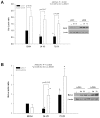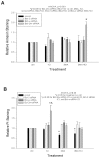Co-inhibition of BCL-W and BCL2 restores antiestrogen sensitivity through BECN1 and promotes an autophagy-associated necrosis
- PMID: 20062536
- PMCID: PMC2797635
- DOI: 10.1371/journal.pone.0008604
Co-inhibition of BCL-W and BCL2 restores antiestrogen sensitivity through BECN1 and promotes an autophagy-associated necrosis
Abstract
BCL2 family members affect cell fate decisions in breast cancer but the role of BCL-W (BCL2L2) is unknown. We now show the integrated roles of the antiapoptotic BCL-W and BCL2 in affecting responsiveness to the antiestrogen ICI 182,780 (ICI; Fulvestrant Faslodex), using both molecular (siRNA; shRNA) and pharmacologic (YC137) approaches in three breast cancer variants; MCF-7/LCC1 (ICI sensitive), MCF-7/LCC9 (ICI resistant), and LY2 (ICI resistant). YC137 inhibits BCL-W and BCL2 and restores ICI sensitivity in resistant cells. Co-inhibition of BCL-W and BCL2 is both necessary and sufficient to restore sensitivity to ICI, and explains mechanistically the action of YC137. These data implicate functional cooperation and/or redundancy in signaling between BCL-W and BCL2, and suggest that broad BCL2 family member inhibitors will have greater therapeutic value than targeting only individual proteins. Whereas ICI sensitive MCF-7/LCC1 cells undergo increased apoptosis in response to ICI following BCL-W+/-BCL2 co-inhibition, the consequent resensitization of resistant MCF-7/LCC9 and LY2 cells reflects increases in autophagy (LC3 cleavage; p62/SQSTM1 expression) and necrosis but not apoptosis or cell cycle arrest. Thus, de novo sensitive cells and resensitized resistant cells die through different mechanisms. Following BCL-W+BCL2 co-inhibition, suppression of functional autophagy by 3-methyladenine or BECN1 shRNA reduces ICI-induced necrosis but restores the ability of resistant cells to die through apoptosis. These data demonstrate the plasticity of cell fate mechanisms in breast cancer cells in the context of antiestrogen responsiveness. Restoration of ICI sensitivity in resistant cells appears to occur through an increase in autophagy-associated necrosis. BCL-W, BCL2, and BECN1 integrate important functions in determining antiestrogen responsiveness, and the presence of functional autophagy may influence the balance between apoptosis and necrosis.
Conflict of interest statement
Figures






References
-
- Jemal A, Siegel R, Ward E, Hao Y, Xu J, et al. Cancer statistics, 2008. CA Cancer J Clin. 2008;58:71–96. - PubMed
-
- Howell A, Robertson JF, Quaresma AJ, Aschermannova A, Mauriac L, et al. Fulvestrant, formerly ICI 182,780, is as effective as anastrozole in postmenopausal women with advanced breast cancer progressing after prior endocrine treatment. J Clin Oncol. 2002;20:3396–3403. - PubMed
-
- Osborne CK, Pippen J, Jones SE, Parker LM, Ellis M, et al. Double-blind, randomized trial comparing the efficacy and tolerability of fulvestrant versus anastrozole in postmenopausal women with advanced breast cancer progressing on prior endocrine therapy: results of a North American trial. J Clin Oncol. 2002;20:3386–3395. - PubMed
-
- Clarke R, Liu MC, Bouker KB, Gu Z, Lee RY, et al. Antiestrogen resistance in breast cancer and the role of estrogen receptor signaling. Oncogene. 2003;22:7316–7339. - PubMed
-
- Clarke R, Leonessa F, Welch JN, Skaar TC. Cellular and molecular pharmacology of antiestrogen action and resistance. Pharmacol Rev. 2001;53:25–71. - PubMed
Publication types
MeSH terms
Substances
Grants and funding
LinkOut - more resources
Full Text Sources
Research Materials

